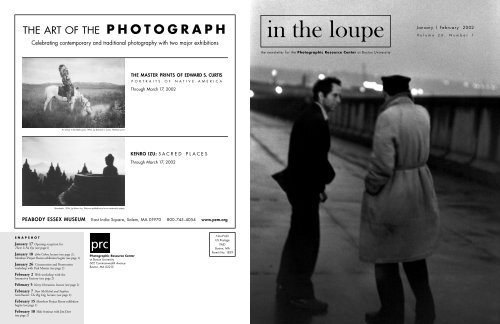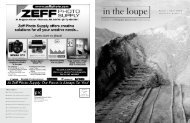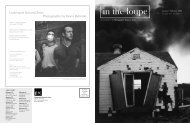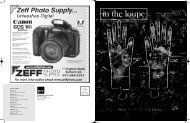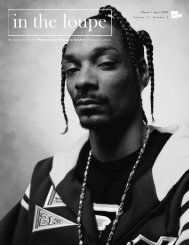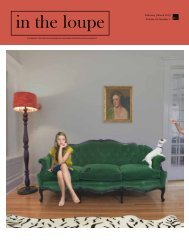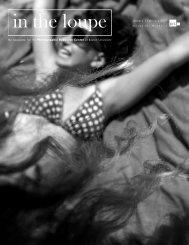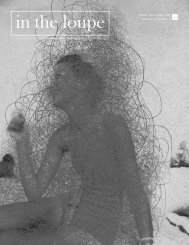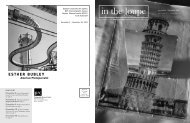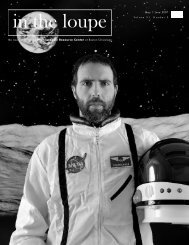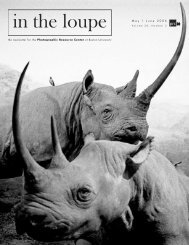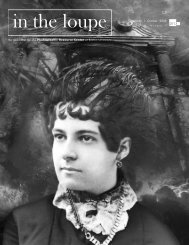January | February 2002 - Boston Photography Focus
January | February 2002 - Boston Photography Focus
January | February 2002 - Boston Photography Focus
You also want an ePaper? Increase the reach of your titles
YUMPU automatically turns print PDFs into web optimized ePapers that Google loves.
THE ART OF THE PHOTOGRAPH<br />
Celebrating contemporary and traditional photography with two major exhibitions<br />
<strong>January</strong> | <strong>February</strong> <strong>2002</strong><br />
Volume 26, Number 1<br />
THE MASTER PRINTS OF EDWARD S. CURTIS<br />
PORTRAITS OF NATIVE AMERICA<br />
Through March 17, <strong>2002</strong><br />
An Oasis in the Bad Lands, 1905, by Edward S. Curtis. Platinum print.<br />
KENRO IZU: SACRED PLACES<br />
Through March 17, <strong>2002</strong><br />
Borobudur, 1996, by Kenro Izu. Platinum palladium print on watercolor paper.<br />
PEABODY ESSEX MUSEUM East India Square, Salem, MA 01970 800-745-4054 www.pem.org<br />
SNAPSHOT<br />
<strong>January</strong> 17 Opening reception for<br />
There Is No Eye (see page1)<br />
<strong>January</strong> 18 John Cohen, lecture (see page 2),<br />
Members Project Room exhibition begins (see page 1)<br />
<strong>January</strong> 26 Conservation and Preservation<br />
workshop with Paul Messier (see page 2)<br />
<strong>February</strong> 2 Web workshop with the<br />
Interactive Factory (see page 2)<br />
<strong>February</strong> 5 Henry Horenstein, lecture (see page 2)<br />
<strong>February</strong> 7 Dan McNichol and Stephen<br />
SetteDucati: The Big Dig, lecture (see page 2)<br />
<strong>February</strong> 15 Members Project Room exhibition<br />
begins (see page 1)<br />
<strong>February</strong> 18 Slide Seminar with Jim Dow<br />
(see page 2)<br />
Photographic Resource Center<br />
at <strong>Boston</strong> University<br />
602 Commonwealth Avenue<br />
<strong>Boston</strong>, MA 02215<br />
Non-Profit<br />
US Postage<br />
PAID<br />
<strong>Boston</strong>, MA<br />
Permit No. 1839
MISSION STATEMENT<br />
The Photographic Resource Center is guided by a philosophical<br />
inquiry into the role of photographic media in the<br />
formation of human knowledge and experience. By emphasizing<br />
new work, ideas, and methods, and by creating opportunities<br />
for interaction among the diverse communities that<br />
it serves, the Photographic Resource Center strives to be a vital<br />
international voice in understanding the past and shaping<br />
the future of photography.<br />
BOARD OF DIRECTORS<br />
Rick Grossman, President<br />
Mark Young, Vice President<br />
Robert Birnbaum<br />
Marvin F. Cook<br />
Andrew Epstein<br />
Joanne P. Evans<br />
Roger Farrington<br />
Keith Johnson<br />
Lou Jones<br />
Emily Kahn<br />
Rodger Kingston<br />
Gary Leopold<br />
John Stomberg<br />
Maggie Trichon<br />
Charles Zoulias<br />
STAFF<br />
Terrence Morash, Executive Director<br />
Leslie Brown, Curator<br />
Alice Hall, Librarian<br />
Ingrid Trinkunas, Coordinator of Programs and Administration<br />
Sarah English, Editorial Assistant<br />
Alisa Mazur, Editorial Assistant<br />
Rohini Sandesara, Editorial Assistant<br />
GENERAL INFORMATION<br />
Photographic Resource Center at <strong>Boston</strong> University<br />
602 Commonwealth Avenue, <strong>Boston</strong>, MA 02215<br />
Tel 617-353-0700 prc@bu.edu<br />
Fax 617-353-1662 www.bu.edu/prc<br />
HOURS<br />
Tuesday–Sunday: 12–5pm<br />
Thursday: 12–8pm<br />
Closed Mondays<br />
ADMISSION<br />
Adults: $3<br />
Students (with valid ID) and Seniors: $2<br />
Members, children under 18,<br />
and school groups are admitted free.<br />
PUBLIC TRANSPORTATION<br />
Take the Green Line “B” train to Blandford Street, one stop<br />
west of Kenmore Square.<br />
COVER IMAGE<br />
John Cohen, Robert Frank and Larry Rivers, New York<br />
City, 1959. Courtesy of the artist and Deborah Bell,<br />
New York. John Cohen captured a rare meeting of noted<br />
photographer and filmmaker Robert Frank with jazz<br />
saxophonist turned pop painter Larry Rivers.<br />
DESIGN CREDITS<br />
This issue of in the loupe was designed by Irma S. Mann,<br />
Strategic Marketing, Inc. of <strong>Boston</strong> (www.irmamann.com).<br />
It was printed by Cambridge Offset Printing on Mohawk<br />
Superfine Ultrawhite 80# text.<br />
A Note from the Director<br />
The alternative arts space emerged in the early 1970s in response to numerous social factors and the<br />
needs of the contemporary art-making community. While galleries and museums focused on the concerns<br />
of audience development, celebrity and funding, these spaces emphasized art and artists. These<br />
motives gave birth to a number of vital cultural centers, such as the Photographic Resource Center,<br />
and remain the defining factors for their existence.<br />
Over the next three decades, numerous challenges faced cultural organizations. Those that survived the<br />
recession and government funding reductions of the early 1990s, spent the last decade rebuilding. As<br />
we are now faced with another economic downturn, these organizations must again struggle to stay<br />
afloat. Some are unable to. In October, the Friends of <strong>Photography</strong>, one of the more influential photography<br />
centers over the past quarter century, closed its doors over a lack of funding and the exorbitant<br />
real estate costs of San Francisco.<br />
The PRC is not immune to these challenges. As we continue to work to provide you with the innovative<br />
programming that fills these pages, we are faced with a reduction in government and foundation<br />
support due to the diminished economy. We need your help. Your support of the PRC through membership,<br />
program participation, attendance, and donations is crucial to its continued survival. Thank<br />
you, in advance, for your continued support. We are truly grateful.<br />
On another note, we are currently in the midst of planning an exhibition to mark the 6 month anniversary<br />
of 9-11. The exhibition will focus on the memorializing and mourning process in which we are all<br />
engaged. We are actively looking for work that addresses the idea of 9-11 shrine-making and use of<br />
photography in our understanding of the tragic events to include in this exhibition. Please visit the<br />
PRC website at www.bu.edu/prc, or call 617-353-0700, for more information and a detailed call for<br />
entries. Hurry though, we ask that submissions are received before the end of <strong>January</strong>.<br />
Best wishes for a great <strong>2002</strong>,<br />
Terrence Morash<br />
Executive Director<br />
Support<br />
The programs and exhibitions of the Photographic Resource Center are made possible<br />
through the generous support of its members, <strong>Boston</strong> University, various government and<br />
private foundations, and corporations including:<br />
Adesso<br />
American Printing<br />
Ardon Vinyl Graphics<br />
Art New England<br />
artsMedia<br />
Associated Press Photos<br />
Becket Papers<br />
<strong>Boston</strong> Beer Company<br />
<strong>Boston</strong> Cultural Council<br />
<strong>Boston</strong> Park Plaza Hotel<br />
<strong>Boston</strong> University<br />
Calumet Photographic<br />
Cambridge Offset Printing<br />
The Charles Hotel<br />
Christie’s<br />
Paula Cooper Gallery<br />
Crestar Mfg.<br />
Arthur Dion<br />
Jim Dow<br />
Eastman Kodak<br />
Jesseca Ferguson<br />
Filene’s<br />
FleetCenter Neighborhood Charities<br />
Fox River Papers<br />
Gay’s Flowers and Gifts<br />
Gourmet Caterers<br />
Hasselblad<br />
Harpoon Brewery<br />
Helicon Design<br />
Henrietta’s Table<br />
Mark Hunt Backdrops<br />
Hunter Editions<br />
Keith Johnson<br />
Deborah Kao<br />
KISS 108 FM<br />
Robert Klein<br />
Lina Kutsovskaya<br />
Rachel Lafo<br />
Lee Gallery<br />
E.P. Levine<br />
Joanne Lukitsh<br />
Luminos Photo. Corp.<br />
Irma S. Mann Strategic Marketing<br />
Massachusetts College of Art<br />
Massachusetts Cultural Council<br />
MassEnvelopePlus<br />
Ted Marrazzo<br />
MCS Frames<br />
Merry Maids<br />
Inge Milde<br />
Museums <strong>Boston</strong><br />
Bruce Myren at Bee Digital<br />
National Endowment for the Arts<br />
Nielsen & Bainbridge Co.<br />
Nikon Inc.<br />
Alison Nordstrom<br />
Nylon Magazine<br />
Olympus<br />
Panopticon, Inc.<br />
Perfecta Camera, Corp.<br />
photocurator.org<br />
<strong>Photography</strong> in New York<br />
Polaroid Corporation<br />
Rialto<br />
Sebastian’s Catering<br />
Sonya’s Catering<br />
Jerry Spagnoli<br />
Spectrum Color Labs, Inc.<br />
Betsy Urrico<br />
WBUR<br />
Howard Yezerski Gallery<br />
Keitaro Yoshioka<br />
Zeff Photo Supply<br />
Zona Laboratories<br />
Zoo New England<br />
PRC<br />
Announcements<br />
Help Rebuild the Library<br />
We are sure that you, like we, truly value the PRC’s<br />
Aaron Siskind Library. Whether you are searching<br />
for that hard to find title, or getting assistance<br />
from our wonderful Librarian, Alice Hall, the<br />
library serves as a unique collection of information<br />
and publications for all of your photography<br />
needs. However, an unfortunate reality is that its<br />
books are occasionally stolen, and we do not have<br />
the resources to replace all of them. We are hoping<br />
that you can help. Below, you will find a list<br />
of some of the key titles that are currently missing<br />
from the library. If you have a copy that you<br />
would like to donate to or purchase for the<br />
library, please let us know.<br />
Avedon, Richard. Portraits. Farrar, Straus & Giroux,<br />
1976.<br />
Bey, Dawoud. Dawoud Bey Portraits.<br />
Walker Art Center, Minnesota, 1995.<br />
Brassai. The Secret Paris of the 30s.<br />
Pantheon Books, 1976.<br />
Callahan, Harry. Harry Callahan New Color<br />
Photographs 1978-1987. Hallmark Cards, 1988.<br />
Clark, Larry. Teenage Lust.<br />
Evans, Walker. Walker Evans. MOMA, 1971.<br />
Freund, Gisele. <strong>Photography</strong> and Society.<br />
Godine, 1980.<br />
Grundberg, Andy. <strong>Photography</strong> and Art:<br />
Interactions since 1946. Abbeville, 1987.<br />
Kertesz, Andre. Andre Kertesz 60 Years. Grossman,<br />
1972.<br />
Kraus, Rosalind. Cindy Sherman 1975 - 1993.<br />
Rizzoli, 1993.<br />
Upcoming Exhibitions<br />
There is No Eye:<br />
Photographs by John Cohen<br />
<strong>January</strong> 18–March 1, <strong>2002</strong><br />
Opening Reception:<br />
Thursday, <strong>January</strong> 17, 5:30-7:30pm<br />
Bakalar and Klebenov Galleries<br />
Curated by John Jacob, Director of photocurator.org<br />
There is No Eye is the first major traveling retrospective<br />
exhibition by John Cohen — the musician<br />
who provided inspiration in part for the Grateful<br />
Dead song “Uncle John’s Band.” As co-founder of<br />
the band the New Lost City Ramblers in 1958 and<br />
a regular writer for Sing Out Magazine, he was<br />
central to the emergence of the urban folk revival<br />
of the 1960s. The title, There is No Eye, comes<br />
from Bob Dylan’s liner notes concerning Cohen in<br />
Highway 61 Revisited (1965).<br />
The exhibition covers all areas of Cohen’s work:<br />
New York City of the 1950s, the Beats, American<br />
traditional music, as well as his travels in Peru and<br />
the American South. Cohen’s formal relationships<br />
are stunningly beautiful, as Greil Marcus notes in<br />
his introduction to the monograph of the same<br />
name: “You can look at John Cohen’s “There Is No<br />
Eye” and see through very familiar eyes: the New York<br />
City eyes of Helen Levitt and Walker Evans, Evans’s<br />
country eyes, the highway eyes of Robert Frank, even<br />
Margaret Bourke-White’s doubting eyes in Holiness<br />
churches.” The exhibition is also accompanied by a<br />
Koudelka, Joseph. Exiles. Aperture, 1988.<br />
Koudelka, Joseph. Gypsies. Aperture, 1975.<br />
Morell, Abe. A Camera in a Room. Smithsonian<br />
Institute, 1995.<br />
Michals, Duane. The Nature of Desire.<br />
Papageorge, Tod. Walker Evans and Robert Frank.<br />
Yale University Art Gallery, 1981.<br />
Solomon-Godeau, Abigail, <strong>Photography</strong> at the Dock.<br />
Sudek, Joseph. Joseph Sudek poet of Prague.<br />
Aperture, 1990.<br />
Smith, Lauren. The Visionary Pinhole, 1985.<br />
Uelsmann, Jerry. Jerry N. Uelsmann 25 years.<br />
Little Brown, 1982.<br />
Weegee. Naked City<br />
Portfolio Reviews<br />
with the Curator!<br />
The PRC’s new Curator, Leslie Brown, will begin<br />
conducting portfolio reviews in <strong>February</strong>. The purpose<br />
of these sessions is wide ranging: from providing<br />
feedback and considering ideas for new shows<br />
to having Leslie meet you and get a sense of the<br />
current work our members are producing. Work<br />
that is photographically based in the broadest conception<br />
— from gelatin silver to iris prints to video<br />
to installations — in any format is welcomed. While<br />
seeing the real work is preferred, slides, transparencies,<br />
work prints, videos (VHS), or CDs can also be<br />
brought. Portfolio reviews will be conducted on<br />
the first Monday of every month (barring a holiday),<br />
with a reservation call-in date set for the third<br />
Friday of the month prior. They will be 45 minutes<br />
long and scheduled on the hour from 9am to 3pm.<br />
Smithsonian Folkways CD compilation featuring<br />
the music of those pictured in the exhibition. Both<br />
will be available for purchase at the PRC. See John<br />
Jacob’s essay on page 4, and Leslie Brown’s essay on<br />
page 7 for more information.<br />
Michael Hintlian and<br />
Camila Chavez-Cortes<br />
<strong>January</strong> 18–<strong>February</strong> 8, <strong>2002</strong><br />
Members Project Room:<br />
An informal space curated and installed by members.<br />
The Members Project Room presents the documentation<br />
of architectural projects by Michael Hintlian<br />
and Camila Chavez-Cortes. Michael has been<br />
working on the development of the “Big Dig”<br />
since 1997. When he started, he quickly saw that<br />
it would be the skill of individual tradespeople that<br />
Michael Hintlian, Central Artery/Tunnel, 1999<br />
Reviews are free for members. Individuals are<br />
restricted to one review per calendar year. The next<br />
review dates, and call-in reservation dates, are listed<br />
below.<br />
REVIEW DATES:<br />
Monday, <strong>February</strong> 4th (Call for reservations at<br />
10am, Friday, <strong>January</strong> 18th)<br />
Monday, March 4th (Call for reservations at<br />
10am, Friday, <strong>February</strong> 15th)<br />
<strong>2002</strong> Members Print Program<br />
At the time of this writing, we are finalizing the<br />
<strong>2002</strong> Members Print Program — a program which<br />
offers original limited edition prints to higher level<br />
members. While the new program will be announced<br />
shortly, we are thrilled to present an exciting array<br />
of fine artists. Among the artists generously participating<br />
in this year’s program are: David<br />
Armstrong, Pamela Ellis Hawkes, Emily Kahn,<br />
Rodger Kingston, Eric Lewandowski, Abelardo<br />
Morell and Karin Rosenthal. Keep your eye out<br />
for the brochure.<br />
Mark Hunts Backdrops has<br />
expanded its inventory!<br />
Every backdrop available for rental at MHB is<br />
available for purchase for a limited time. For more<br />
information, visit www.markhuntbackdrops.com,<br />
call 617-951-0737, or email mark@markhuntbackdrops.com.<br />
PRC members get an additional 10% off<br />
during this sale!<br />
would make this project a reality. He also realized<br />
that this would be the first thing forgotten. It has<br />
become very important to him to separate the<br />
integrity of the workers from the politics and negative<br />
press through his photography. Camila will<br />
present her photos of the landscape transformation<br />
of Berlin 1994–2001. She focused her lens on<br />
the vestiges of old and burgeoning new sites:<br />
wrapped buildings and overnight transformations<br />
of green landscapes, empty lots and demolished<br />
spaces, and glass facilities designed by an international<br />
cadre of architects."<br />
Continuum of Time Exposed<br />
<strong>February</strong> 15–March 8, <strong>2002</strong><br />
Members Project Room: An informal space curated<br />
and installed by members.<br />
Continuum of Time Exposed challenges the common<br />
notion that photography simultaneously<br />
captures all of the elements of a scene on a sensitive<br />
surface. Christian Waeber and Nancy Wynn<br />
will both present images obtained by slowly scanning<br />
their subjects. Christian uses a panoramic<br />
camera with a rotating lens to slowly scan his<br />
models while they move in front of him, transforming<br />
them into dreamlike human-flower<br />
chimeras. Nancy’s images are metaphors of the<br />
human condition. They are created using the photographic<br />
environment of a digital scanner.<br />
1
education programs at the<br />
WORKSHOPS<br />
Identification and Preservation<br />
of 19 th Century Photographic<br />
Techniques with Paul Messier<br />
Saturday, <strong>January</strong> 26, <strong>2002</strong>, Morning Lecture<br />
9am–12pm, Afternoon Workshop 1–4pm<br />
Photographic Resource Center<br />
Morning-only: $20 Members/$25 Non-Members<br />
Full-day: $75 Members/$100 Non-Members<br />
Reservations required. Please call 617-353-0700<br />
Paul Messier will lead a two part workshop on the<br />
identification and preservation of 19th Century<br />
photographic techniques. During the morning session,<br />
Paul will introduce the various 19th century<br />
photographic processes with an emphasis on identification<br />
and preservation. For those partaking in<br />
the afternoon workshop, Paul will bring in a selection<br />
of photographs from his study collection. He<br />
will guide participants in the methodology used to<br />
identify the various photographic processes. Following<br />
this hands-on session, he will present a slide talk<br />
focusing on deterioration and preservation issues<br />
pertaining to photographs. Participants are invited<br />
to bring in easily transported photographs from<br />
their own collection for identification and preservation<br />
recommendations. Paul is an extensively trained<br />
conservator who was head conservator in the paper<br />
and photographic materials lab of the Rocky Mountain<br />
Conservation Center, Denver. He currently teaches<br />
photography conservation at Buffalo and is a regular<br />
lecturer at Williams College and MIT. He is also a<br />
leader in the emerging field of electronic media preservation.<br />
To read more about Paul’s background and<br />
current work go to www.paulmessier.com.<br />
Shooting Slides 101:<br />
A Workshop and Slide<br />
Presentation with Jim Dow<br />
Monday, <strong>February</strong> 18, 2001, 12:30–2pm<br />
Photographic Resource Center<br />
$30 Members/$40 Non-Members<br />
Reservations recommended.<br />
Please call 617-353-0700<br />
Shooting slides of exhibition spaces and individual<br />
artwork can be tricky. Learn once and for all,<br />
the ins and outs of shooting your artwork and<br />
exhibitions, in order to keep a professional and<br />
accurate representation of them in your portfolio.<br />
Join acclaimed photographer, Jim Dow, in the<br />
PRC galleries as he demonstrates these crucial<br />
skills. He will end the workshop with a slide presentation<br />
of some of his unique interior and exterior<br />
shots. Jim received three National Endowment<br />
for the Arts Fellowships and has a touring exhibition<br />
through the Smithsonian Institution. His work is<br />
included in a number of major collections and he<br />
has a long list of one-person exhibitions. He is currently<br />
a full-time faculty member at SMFA and a<br />
visiting lecturer at Harvard University.<br />
Building an Online Portfolio:<br />
A Workshop for Photographers<br />
Co-Sponsored by the PRC and the Interactive Factory<br />
First day: Saturday, <strong>February</strong> 2, <strong>2002</strong>, 1–6pm<br />
Second day: Participants choose from<br />
Saturdays <strong>February</strong> 9, <strong>February</strong> 16,<br />
<strong>February</strong> 23, <strong>2002</strong>, 9am–5pm.<br />
The Interactive Factory, 368 Congress Street, 4th floor,<br />
<strong>Boston</strong>, MA 02210<br />
$250 Members/ $250+membership Non-Members<br />
Reservations required. Please call the Interactive Factory<br />
directly at 617-426-0609.<br />
The Interactive Factory will lead a two-day workshop<br />
at its state-of-the-art facilities to prepare<br />
photographers and their photography for the web.<br />
The first part of the workshop will be an in-depth<br />
lecture/presentation providing an introduction to<br />
web design issues, geared specifically towards photographers.<br />
Topics covered will include design<br />
concepts for the web, essential hardware and software,<br />
information architecture, bandwidth considerations,<br />
copywriting, and finding a web hosting<br />
service. The second part of the workshop will be<br />
a hands-on day in which participants create a web<br />
page using their own copy and photographs.<br />
Participants will learn basic HTML concepts, then<br />
learn how to use Photoshop and ImageReady to<br />
prepare photographs for the web. Finally, they<br />
will learn how to upload web pages to a web server.<br />
For more information about the Interactive Factory,<br />
please visit them at www.ifactory.com.<br />
LECTURES<br />
Henry Horenstein: Aquatics,<br />
Lecture and Book Signing<br />
Tuesday, <strong>February</strong> 5, <strong>2002</strong>, 6pm<br />
Photographic Resource Center<br />
$5 Members/$10 Non-Members<br />
Reservations recommended. Please call 617-353-0700<br />
Join us for lecture and booksigning by acclaimed<br />
photographer, Henry Horenstein. Henry will present<br />
the work from his new book Aquatics which<br />
represents a series of platinum prints of marine life.<br />
The prints will be on display at the Robert Klein<br />
Gallery from <strong>January</strong> 11–<strong>February</strong> 16, <strong>2002</strong> (please<br />
see the exhibition details on page 10).<br />
Stephen SetteDucati, The Acela Wink at South Station, 2001<br />
Dan McNichol and<br />
Stephen SetteDucati:<br />
The Big Dig<br />
Co-sponsored by the New England School of<br />
<strong>Photography</strong> and the PRC<br />
Thursday, <strong>February</strong> 7, <strong>2002</strong>, 7:30 pm<br />
Location to be announced.<br />
Free to the public.<br />
Reservations recommended. Please call 617-353-0700.<br />
Join us for a lecture/presentation on The Big Dig:<br />
the largest construction project in the history of the<br />
United States and the most complex urban project<br />
ever undertaken in the world. <strong>Boston</strong>’s own personal<br />
love-hate relationship. Dan is the author of<br />
the new and best selling book, The Big Dig, and the<br />
soon to be published Big Dig At Night. As an official<br />
spokesperson for the project for nearly eight<br />
years, Dan has led the production of numerous<br />
documentaries about the project while working<br />
with The Discovery Channel, NOVA, The Learning<br />
Channel and History Channel, as well as the American<br />
and German Public Television Networks.<br />
Stephen is the featured photographer in the latter<br />
book. His photographs have been featured in<br />
Architecture magazine, on the Discovery Channel and<br />
on CBS Sunday Morning.<br />
John Cohen:<br />
Lecture and Book Signing<br />
Friday, <strong>January</strong> 18, <strong>2002</strong>, 6pm<br />
Photographic Resource Center<br />
$5 Members/$10 Non-Members<br />
Reservations recommended. Please call 617-353-0700.<br />
John Cohen (see page 4) will discuss his life and<br />
work, amidst the exhibition. Come hear about<br />
his ineraction with the Beat generation and the<br />
world of old-time country, roots and folk music.<br />
After the lecture, he will sign copies of his monograph<br />
There is No Eye. Books will be available at<br />
the PRC for $45.<br />
Matthias Vriens, Nu Masqué, 2000<br />
Featuring forty of today’s most celebrated<br />
photographers, this is the first exhibition to<br />
visualize the debate between aesthetics and<br />
commercial pressures in fashion photography.<br />
Open Wed & Fri, noon–5pm; Thurs, noon–9pm;<br />
Sat & Sun, 11am–5pm<br />
Lou Jones, Boy and Poster, Havana, Cuba, 1980<br />
Creativity and Commerce in Contemporary Fashion <strong>Photography</strong><br />
<strong>January</strong> 23 – May 5, <strong>2002</strong><br />
955 Boylston Street, <strong>Boston</strong> 617-266-5152 www.icaboston.org<br />
Two Views of Cuba:<br />
Photographs by Lou Jones and Peter Kayafas<br />
<strong>January</strong> 19 – March 17, <strong>2002</strong><br />
DeCordova Museum and Sculpture Park<br />
51 Sandy Pond Road, Lincoln, MA 01773<br />
781/259-8355 www.decordova.org<br />
Media sponsor<br />
Fashion lounge<br />
provided by<br />
2 3
john cohen & why there is no<br />
I like to say that I grew up with John Cohen’s music, but that’s<br />
not exactly true. More accurately, I grew up with the songs popularized<br />
by John and his family, notably the collection of American<br />
Folk Songs for Children published in the 1940s by composer Ruth<br />
Crawford Seeger and re-interpreted by countless musicians, among<br />
them her step-son (and John’s brother-in-law) Pete Seeger. I didn’t<br />
actually begin listening to the New Lost City Ramblers, the band<br />
that John co-founded in 1958 with Mike Seeger and Tom Paley,<br />
until high school, when I discovered the Lincoln Center Music<br />
Library, the Musical Heritage Society, and Folkways Records all<br />
within walking distance of home.<br />
Although it’s for his music and work with musicians that he is<br />
most widely recognized, John Cohen started out as a visual artist.<br />
During the early 1950s, John studied painting with Josef Albers<br />
and photography with Herbert Matter at Yale University; he moved<br />
to New York City in 1957. At the time of his arrival there, the<br />
Abstract Expressionists still held sway, and were easy to find presiding<br />
over conversations downtown at the Cedar Bar. In the<br />
cooperative galleries on the Lower East Side, Pop Art was emerging<br />
in the happenings of Red Grooms and Claes Oldenberg, while<br />
in the coffeehouses of nearby Greenwich Village the Beat poets<br />
were reading, and at the Folklore Center on MacDougal Street<br />
the urban folk-music scene was being born.<br />
John Cohen, Roscoe Holcomb, 1964. Courtesy of the artist and Deborah Bell, New<br />
York. John Cohen “discovered” one of the most noted old-time Appalachian musicians,<br />
Roscoe Holcomb, in Daisy, Kentucky in 1959. Cohen later made a film about his hardscrabble<br />
life, “The High Lonesome Sound.” This portrait by Cohen appears on the<br />
cover of Holcomb’s 1965 Folkways release of the same name.<br />
4 5
an improvisation on<br />
mus i c and photograp<br />
Leslie K. Brown, Curator, PRC<br />
From his loft on Third Avenue, John immersed himself in the ferment of<br />
the New York City art scene. Soon after he arrived, John had his first exhibition<br />
at Helen Gee’s Limelight. In 1959, his neighbor Robert Frank asked<br />
an shared. experience<br />
Of Dylan, Cohen recalls a moment in 1962, when he “showed me the words<br />
The eye permits us to experience and to document the thing depicted, but is rarely sufficient to convey the deeper meaning of<br />
John to take production stills of the filming of Pull My Daisy. The images<br />
produced during those sessions are among the finest portraits ever of Allen<br />
Ginsberg, Jack Kerouac, and Frank himself. In return, Frank photographed<br />
the New Lost City Ramblers for a series of images that would grace the<br />
covers and liner notes of their albums for years to come. John’s loft became<br />
a crossroads for musicians and artists. An organization of independent photographers,<br />
with members including Lee Friedlander, Gary Winogrand, and<br />
others, was formed there. Southern musicians on their way to and from<br />
performances dropped by, as did Woody Guthrie, Alan Lomax, and others<br />
involved in the folk-music revival.<br />
Throughout the late ’50s and early ’60s, Cohen toured extensively with the<br />
New Lost City Ramblers, sharing the stage with rural musicians like Roscoe<br />
Holcomb and the Stanley Brothers as well as with emerging stars such as<br />
Bob Dylan and Joan Baez. Robert Cantwell, whose When We Were Good<br />
(1996) outstandingly documents the growth and decline of the folk music<br />
revival, noted that during this period the Ramblers “raised the nap of the<br />
revival with newly esotericized discographic sources and a performance style<br />
that sounded as exotic as a Tibetan prayer.”<br />
Also during the late 1950s Cohen took the first of many trips to Peru,<br />
ostensibly to study Andean textile production. In the isolated mountain<br />
region of Q’eros he photographed Indian weavers at work, learning their<br />
vocabulary and rituals and developing a deep appreciation for Andean<br />
music. Years later, Cohen returned to Q’eros to make the films Mountain<br />
Music of Peru (1984) and Carnival in Q’eros (1992). He also recorded and<br />
released two albums of traditional Peruvian music. One of his recordings,<br />
of a young girl singing an Andean huano, was included as a sample of the<br />
sounds of our planet that was sent into space on the Voyager spacecraft.<br />
In 1962, the young Bob Dylan visited for a portrait session on John’s Third<br />
Avenue rooftop. In addition to their common appreciation for traditional<br />
music, the two men shared a close friendship with the ailing Woody Guthrie.<br />
to his new song A Hard Rain’s Gonna Fall. At first it resembled the old ballad<br />
Lord Randall or Where Have You Been Billy Boy. Then it seemed like an<br />
old French symbolist poem to me, and I invited Bob to look at some of<br />
that poetry at my loft. I thought his verses were very strong although I<br />
couldn’t imagine how he would fit them to music. The night of the Cuban<br />
Missile Crisis when it felt like the world was on the brink of atomic collision,<br />
Dylan and I sang together at the Gaslight Café. We did an old Carter<br />
Family song, You’re Gonna Miss Me When I’m Gone, not certain if there’d be<br />
anyone left to miss us.”<br />
By the late ’60s the Ramblers were performing in large halls like the Fillmore,<br />
in lineups with supergroups such as The Grateful Dead, the Jefferson<br />
Airplane, and the Jimi Hendrix Experience. Cohen notes that during this<br />
time “a shift of sensibilities set in. The beat generation had prepared the<br />
stage for the counter culture, while the emerging civil rights movement<br />
shook the social landscape… For me, a decade of wide-eyed wandering<br />
with my camera was closing down… So much of what I’d responded to on<br />
a poetic level was becoming entertainment and commerce… Further, there<br />
was my own dissatisfaction with the prospects of ever getting my work seen<br />
on its intended level. By the time the photography galleries were opening<br />
I was somewhere else.” That “somewhere else” was filmmaking.<br />
John shot his first film, a silent two-reeler, on the rooftop with Dylan.<br />
Beginning with his landmark 1962 feature, The High Lonesome Sound,<br />
John has made a total of fifteen documentary films, including important<br />
work on the folk culture of Peru and on the North Carolina musician<br />
Dillard Chandler (The End of an Old Song, 1970). “I made films about<br />
music,” he writes. “And that challenge became so great and transformative<br />
that it became my main effort for the next twenty years.”<br />
Behind the scenes, but central to the picture, is the growth of John’s own family.<br />
In the early 1960s, Cohen married Penny Seeger. The youngest child of<br />
musicologist Charles Seeger and composer Ruth Crawford Seeger, after the<br />
death of her mother when Penny was eight she lived with her half-brother<br />
Pete. A potter by training, she also sang with her siblings Mike and Peggy on<br />
several collections of American folk music, including the classics American<br />
Folk Songs for Christmas and Animal Folk Songs for Children, both of which<br />
drew extensively from their mother’s folk music collection. To support his<br />
family, John took a position as Professor of Visual Arts at the State University<br />
of New York, Purchase, where he worked until his retirement in 1997.<br />
Penny and John raised two children, Rufus and Sonja, in Putnam Country,<br />
New York. In the summer of 1965, when daughter Sonja was still an infant,<br />
her parents brought her to the Newport Folk Festival where the Ramblers<br />
were scheduled to perform. Uncle Pete Seeger opened the program by playing<br />
a cassette of Sonja crying, announcing to the audience, “Here’s the real<br />
folk music.” Sonja, now an adult, has recorded two highly regarded recordings<br />
with composer Dick Connette’s Last Forever project, which draws its<br />
inspiration from American traditional music. Her brother Rufus, also a<br />
musician, works in New Mexico as a textile craftsman. The Cohen family<br />
is featured in both the exhibition, where photographs document their<br />
growth, and in John’s CD, There Is No Eye: Music for Photographs. The CD<br />
presents a musical counterpoint to the exhibition, with songs by many of<br />
the artists whom John photographed, from Rev. Gary Davis and Holcomb<br />
to Dylan and David Amram, and includes pieces by Rufus and Sonja.<br />
In all of John Cohen’s work, his collecting, photographing, filmmaking,<br />
performing, teaching, and parenting, a layer of pure fact (i.e., the thing<br />
depicted) is combined with a layer of meaning conveyed (i.e., the memory<br />
revived or the tradition shared). The eye permits us to experience and to<br />
document the thing depicted, but is rarely sufficient to convey the deeper<br />
meaning of an experience shared. Individual songs or photographs may<br />
describe specific moments in time, and each moment possess a distinct historical<br />
narrative, which we may know by looking.<br />
But experience is not conveyed by looking, or wisdom by simply reading.<br />
This has been a central theme of the New Lost City Ramblers, and it is<br />
implicit in John Cohen’s photographs as well. Meaning and value are conveyed<br />
not through the eye alone, but through the active and generous<br />
bequest of tradition and knowledge from one generation to another, from<br />
one culture to another, from teacher to student, and from parent to child.<br />
This, for me, is the underlying message of John Cohen’s work, and the<br />
deeper narrative of this exhibition: there is no eye because, in the end, it is<br />
the exchange of songs, the sharing of wisdom, the flow of knowledge, and<br />
the gift of life that are important, and not the individual eye/I.<br />
John P. Jacob, Guest Curator<br />
Penobscot, Maine 2001<br />
John Cohen’s photograph, Jack Kerouac Listening to<br />
Himself on the Radio, (seen at left) demonstrates, literally and humorously, the<br />
complex conundrum photographers face when attempting to document subjects<br />
of an auditory nature. Can photography adequately capture a musical<br />
moment by recording the performer, or even a snippet of the performance?<br />
In this short improvisation, an etude if you will, I attempt to cast a wider net<br />
and muse upon Cohen’s fascinating photographs within a larger historical<br />
and philosophical context.<br />
From its inception, photography has been lauded as a method for nature to<br />
reproduce itself. While this was meant primarily in the visual sense — cameras<br />
were often compared to eyes — artists have long attempted to capture the<br />
non-perceptual. Those seeking the abstract saw in sound an equivalent for<br />
the internal non-objective world for which they were searching: an aesthetic<br />
“music of the spheres”. While photography and dance seemed to partner more<br />
readily, painting took especially to music: James Abbott McNeill Whistler<br />
and Wassily Kandinsky titled their canvases symphonies and compositions,<br />
while Piet Mondrian explored the pulsating rhythms of jazz.<br />
This is not to say that photographers did not engage music or its attendant<br />
ideas. In fact, some saw photography as particularly suited for the task.<br />
Cohen alludes to this ability when explaining why he did not become a<br />
painter: “The lens became the center of an equation with the visible world on<br />
one side and the interior world on the other.” Many culture mavens at the<br />
turn of the last century were interested in synaesthesia, or the crossing of various<br />
senses whereby one could see music and hear colors. Such beliefs led to<br />
the invention of fascinating instruments such as the color organ, which<br />
played colors instead of music. Photographer Francis Brugiuère made some<br />
of the earliest abstract photographs and films documenting patterns produced<br />
by such an apparatus. Playing off the Theory of Correspondences so<br />
popular with the Symbolists, Alfred Stieglitz photographed clouds, initially<br />
titling them “Music,” intending that they stand in for mental states akin to<br />
those induced by melodies.<br />
Cohen’s exhibition, book, and accompanying CD provide the viewer (and<br />
listener) with a rare opportunity to see (and to hear) what he has recorded.<br />
Although freezing performers in mid refrain or strum, his photographs are not<br />
silent; instead they sing with beautiful formal relationships. When Cohen’s<br />
photographs don’t show music, they imply it, transforming the viewer into a<br />
makeshift deejay. Images of Cohen’s wife in Peru and a lone figure in a Tenth<br />
Street studio, for example, almost give rise to a melancholy dirge.<br />
One would think that photography’s use of a negative and its ability to be<br />
repeated and reinterpreted much like a musical score would make these arts<br />
close cousins. Ansel Adams’s much-repeated comparison of the negative to<br />
sheet music and its printing to performance alludes to this attribute. Quite<br />
the opposite, many photographers even go so far as to destroy their negatives<br />
so no one can translate them. Ironically or aptly, Cohen’s re-discovery of<br />
Left to right: 1. John Cohen, Woody Guthrie at Cooper Union. Courtesy of the artist and<br />
Deborah Bell, New York. 2. John Cohen, Third Avenue, New York City, 1962. Courtesy of the<br />
artist and Deborah Bell, New York. 3. John Cohen, Philadelphia, 1961. Courtesy of the artist<br />
and Deborah Bell, New York. 4. John Cohen, Jack Kerouac listening to himself on the radio.<br />
Courtesy of the artist and Deborah Bell, New York. 5. John Cohen, Harlem, New York City,<br />
1954. Courtesy of the artist and Deborah Bell, New York. 6. John Cohen, Harlem, New York<br />
City, 1954. Courtesy of the artist and Deborah Bell, New York.<br />
(continued on page 8)<br />
6 7
(continued from page 7)<br />
bygone musical genres would not have been possible had the original arrangements<br />
been lost or forgotten.<br />
Music, photography, and film all invoke time. Cohen’s artistic practices slice<br />
this continuum at many intervals. On the one hand, a photograph is sometimes<br />
the only evidence that an act of art has occurred and becomes entwined<br />
in the art making process, as in the use of photographs by performance artists.<br />
On the other hand, in order to convey the passage of time, film is often the<br />
preferred medium. Cohen tackled several temporal aspects: recording several<br />
“happenings,” shooting film stills, and even producing his own documentaries<br />
about music.<br />
Today, disciplines blend so much so that the term “photographic arts” is often<br />
used in lieu of photography. Even the history of photography as a discrete<br />
entity has come into question. Cohen’s body of work, crossing music, photography,<br />
film, and performance as it does, brilliantly illustrates this confluence<br />
as well as the very crux of the Photographic Resource Center’s mission.<br />
In the end, if a comparison is desired, Cohen’s photographs are perhaps closest<br />
in kin to poetry, a similarity he himself noted: “Photographs were like<br />
poetry to me, triggering ideas, stimulating images in the mind. Images that<br />
were too active to sit on a wall.” As we stare at Kerouac’s thoughtful, puzzled<br />
countenance, we are left to surmise what sort of ideas and images were created<br />
in his mind; and maybe, that’s the wonder of it all.<br />
John Cohen, Tenth Street, New York City, 1959. Courtesy of the artist and Deborah Bell,<br />
New York.<br />
8 9
10<br />
photography events in new england and<br />
EXHIBITIONS<br />
MASSACHUSETTS<br />
Arlington Center for the Arts, Gibbs Gallery<br />
Reflections of Midlife: Works by Elizabeth Buckley, Karen Davis,<br />
Andrea Geyer, and Nancy Hart (Jan 22–Mar 1, <strong>2002</strong>). 41<br />
Foster St., Arlington, MA 02474. 781-648-6220.<br />
Art Institute of <strong>Boston</strong><br />
Sun Works: Contemporary Alternative <strong>Photography</strong> (thru Jan<br />
18). Mon–Sat, 9–6pm, Sun 12–5pm. 700 Beacon St.,<br />
<strong>Boston</strong>, MA 02215. 617-262-1223. www.aiboston.edu.<br />
Arthur Griffin Center for Photographic Art<br />
American Hollow: Photographs of an Appalachian Family by<br />
Steve Lehman (thru Jan 13). Tue–Sun, 12–4. 67 Shore Rd.,<br />
Winchester, MA 01890. 781-729-1158.<br />
www.griffincenter.org<br />
Bernard Toale Gallery<br />
Manifest: Photographs by Deborah Bright (Jan 2–26, opening<br />
Jan 4). Tues–Sat, 10:30–5:30. 450 Harrison Ave., <strong>Boston</strong>,<br />
MA 02118. 617-482-2477. www.bernardtoalegallery.com<br />
Cambridge Multicultural Arts Center<br />
Reconstructing Kosovo: Photographs by Glenn Ruga, Frank<br />
Ward and Barbara Ayott (thru Jan 11). Mon–Fri, 9:30–5:30.<br />
41 Second St., Cambridge, MA 02141. 617-577-1400.<br />
www.cmacusa.org<br />
Danforth Museum of Art<br />
Carnaval in Canvas: Photographs by Brazilian photographer<br />
Rogerio Reis (Jan 17–May 12). Wed–Sun, 12–5. 123 Union<br />
Ave., Framingham, MA 01702. 508-620-0050.<br />
www.danforthmuseum.org<br />
DeCordova Museum and Sculpture Park<br />
Two Views of Cuba: Photographs by Lou Jones and Peter<br />
Kafayas (Jan 19–Mar 17). Tue–Sun, 11–5. 51 Sandy Pond<br />
Rd., Lincoln, MA 01773. 781-259-8355.<br />
www.decordova.org<br />
Firehouse Center for the Arts<br />
Collection of Moments: Black and White <strong>Photography</strong> from the<br />
1970s by Jeremy Barnard (Jan 30–Feb 25). Tue–Sat, 10–5.<br />
Market Square, Newburyport, MA 01950. 978-352-8280.<br />
EDUCATION<br />
Karin Rosenthal will be teaching a workshop on photographing<br />
the nude in the landscape, in Maui, Hawaii in <strong>February</strong><br />
<strong>2002</strong>. For further information contact Maui Photo Workshops<br />
at 800-314-2994 or www.mauiphotoworkshops.com<br />
DeCordova Museums and Sculpture Park: Meet the Artists<br />
and Curators. Every Saturday at 3pm the DeCordova Museum<br />
hosts conversations with artists/curators. In relation to Two<br />
Views of Cuba: Photographs by Lou Jones and Peter Kayafas. Jan<br />
19 meet Peter Kayafas, Mar 9 meet Lou Jones. Third Floor<br />
Main Lobby. 51 Sandy Pond<br />
ENTRIES/OPPORTUNITIES<br />
Harvard Art Museums, Fogg Art Museum<br />
A Curious and Ingenious Art: Reflections on Daguerreotypes at<br />
Harvard (Jan 19–Apr 14). Mon–Sat, 10–5, Sun, 1–5. 32<br />
Quincy St., Cambridge, MA 02138. 617-495-9400.<br />
www.artmuseums.harvard.edu/fogg<br />
Howard Yezerski Gallery<br />
John Coplans (Feb 1–26). Tue–Sat, 10–5:30. 14 Newbury St.,<br />
<strong>Boston</strong>, MA 02116. 617-262-0550.<br />
www.howardyezerskigallery.com<br />
Institute of Contemporary Art<br />
Chic Clicks: Creativity and Commerce in Contemporary<br />
Fashion <strong>Photography</strong> (Jan 23–May 5). Wed, Fri, 12–5;<br />
Thur, 12–9; Sat-Sun, 11–5. 955 Boylston St., <strong>Boston</strong>, MA.<br />
617- 266-5152. www.icaboston.org<br />
Massachusetts College of Art, Bakalar Gallery<br />
Photographs by Mimmo Jodice (thru Jan 11). Mon–Fri, 10–5.<br />
621 Huntington Ave., <strong>Boston</strong>, MA 02115. 617-879-7000.<br />
www.massart.edu<br />
Museum of Fine Arts, <strong>Boston</strong><br />
The Look: Images of Glamour and Style; Photographs by Horst<br />
and Hoyningen-Huene. (thru Jan 6). Mon, Tue, 10–4:45;<br />
Wed–Fri, 10–9:45; Sat, Sun, 10–5:45. Avenue of the Arts,<br />
465 Huntington Ave., <strong>Boston</strong>, MA 02115. 617-267-9300.<br />
www.mfa.org<br />
New England School of <strong>Photography</strong>, Gallery One<br />
Cameraless Photographs by Norman Sarachek<br />
(Jan 7–Feb 8, <strong>2002</strong>).<br />
Shadows and Ghosts (Feb 11–Mar 15). Mon–Fri, 9–5<br />
537 Commonwealth Ave., <strong>Boston</strong>, MA 02215.<br />
617-437-1868. www.nesop.com<br />
Panopticon Gallery<br />
Mon–Fri, 10–6 pm, 435 Moody St., Waltham.<br />
781-647-0100<br />
Peabody Essex Museum<br />
Kenro Izu: Sacred Places (thru Mar 17)<br />
The Master Prints of Edward S. Curtis (thru Mar 17).<br />
Tue–Sat, 10–5, Sun, 12–5. East India Square, Salem,<br />
MA 01970. 978-745-9500. www.pem.org<br />
Road, Lincoln, MA 01773. Visit www.decordova.org or call<br />
781-259-8355 for more information.<br />
Horizons to Go is offering two great photographic workshops<br />
this summer. A Photographic Medley: Polaroid Transfers,<br />
Cyanotypes and More with Joan Fitzsimmons is offered April<br />
19–26 and takes place in Southern France. <strong>Photography</strong><br />
“Independent” with Mini-Workshop is offered April 13–20<br />
and will take place in Albuquerque and Acoma, AZ. For<br />
more information, contact Horizons to Go at PO Box 2206,<br />
Amherst, MA 01004, call 413-549-2900, fax 413-549-5995<br />
or e-mail horizons@horizons-art.com.<br />
The Firehouse Gallery, Newburyport, MA, announces its<br />
annual call for entries for the exhibition year beginning July<br />
<strong>2002</strong>. Open to all performing and visual artists. Deadline<br />
<strong>January</strong> 15, <strong>2002</strong>. Send 10–20 slides with Bio/statement, $20<br />
entry fee and self addressed, stamped envelope to Firehouse<br />
Gallery Director, Market Square, Newburyport, MA 01950.<br />
For additional info go to www.firehousecenter.com<br />
The SRO Photo Gallery at the School of Art, Texas Tech<br />
University will host a competition to fill nine photographic<br />
exhibitions each year. Slide portfolios are viewed and considered<br />
for possible individual exhibitions by a committee from<br />
the <strong>Photography</strong> Division of the School of Art and Gallery<br />
Coordinator. They are looking for strong portfolios of creative<br />
photography in all styles, techniques and aesthetic<br />
approaches. For more info, write to: SRO — Photo Gallery,<br />
Texas Tech University, School of Art, Attn. Zachary<br />
McFarlen, PO Box 42081, Lubbock, TX 79409-2081.<br />
Deadline for entries is April 2, <strong>2002</strong>.<br />
The Santa Fe Center for Visual Arts is calling for entries<br />
for its seventh-annual competitions. There are four topics<br />
one can choose to apply to: Project Competition, Vision<br />
Awards, Photographic Teaching Awards, and Light Warriors<br />
Mentorship Program. The deadline for entries is <strong>January</strong> 22,<br />
<strong>2002</strong>. For a prospectus, send a business-size SASE to: Vision<br />
<strong>2002</strong>, P.O. Box 2483, Santa Fe, NM 87504. For more information<br />
on the <strong>2002</strong> contest visit the contest section at<br />
www.santafeworkshops.com.<br />
The Asian American Arts Centre’s Artists Slide Archive will<br />
be accepting submissions until June 20, <strong>2002</strong>. The Artists<br />
Slide Archive program is designed as a registry of contemporary<br />
Asian American artists as well as a permanent historical<br />
record of the cultural presence of Asians in America. Works<br />
of all media created by artists of Asian descent are welcomed,<br />
as well as artists strongly influenced by Asia. For more information,<br />
contact the Asian American Arts Centre, 26 Bowery,<br />
New York, NY 10013, 212-233-2154, aaartsctr@aol.com<br />
The Indianapolis Art Center is calling for artists to participate<br />
in their exhibition Religion, Spirituality, and the Object,<br />
slated for their 2003-2004 season. Preference is given to<br />
artists within 250 miles of Indianapolis and to “artists working<br />
within their own spiritual beliefs or traditions from a<br />
position of knowledge and respect. Artwork representing,<br />
depicting, or based on any faith or spiritual belief, traditional<br />
or non-traditional considered.” All works in the following<br />
categories considered: liturgical objects or garments designed/<br />
fabricated by the artist, 2D or 3D artwork with religious or<br />
spiritual theme/intent, or artwork used to express a personal<br />
crisis of faith. Approximately 20 artists are chosen. Honorarium<br />
and catalogue pending funding. Send up to 20 slides or<br />
CD-ROM with images, resume, an artist statement specifi-<br />
in the loupe listings deadlines<br />
March/April issue:<br />
<strong>January</strong> 15, <strong>2002</strong><br />
May/June issue:<br />
March 15, <strong>2002</strong><br />
Robert Klein Gallery<br />
Aquatics: Photographs by Henry Horenstein (Jan 11–Feb 16,<br />
opening and book signing Jan 11 6–8). Tue-Fri 10–5:30,<br />
Sat 11–5 and by appt. 38 Newbury St., <strong>Boston</strong>, MA 02116<br />
617-267-7997. www.robertkleingallery.com<br />
Rose Art Museum<br />
Inigo Manglano-Ovalle (Jan 24–Apr 7). Tue-Sun, 15–5,<br />
Thurs, 12–9. Brandeis University, 415 South St., Waltham,<br />
MA 02454. 781-736-3434. www.brandeis.edu/rose<br />
Sullivan Properties<br />
Camila’s Central Artery (ongoing thru Spring <strong>2002</strong>)<br />
200 State St., <strong>Boston</strong>, MA 02109. 617-497-2638<br />
camila@mit.edu<br />
ELSEWHERE IN NEW ENGLAND<br />
Farnsworth Art Museum<br />
Amy Toensing: Monhegan Photographs (Jan 6–Apr 17).<br />
Tue-Sat, 10–5, Sun, 1–5. 356 Main St., Rockland,<br />
ME 04841. 207-596-6457. www.farnsworthmuseum.org<br />
RISD Museum<br />
By Mouth and Hand: Ann Hamilton 1990-2001 (thru Jan 20,<br />
Video Screening with Artist Jan 16, 6:15, Talk and Book<br />
Signing Jan 17, 7:30). Tue-Sun, 10-5, 3rd Thur monthly,<br />
10-9. RISD, 224 Benefit St., Providence, RI 02903<br />
401-454-6502. www.risd.edu/museum<br />
The Santa Fe Workshops offer many <strong>Photography</strong> and<br />
Digital Workshops in <strong>February</strong> and March. One workshop,<br />
In Search of the Personal, is taught by PRC member, John<br />
Goodman. For further info, please contact the Santa Fe<br />
Workshops, call 505-983-1400, fax 505-989-8604, e-mail<br />
info@santafeworkshops.com, or www.santafeworkshops.com.<br />
Art Institute of <strong>Boston</strong> at Lelsey University The Office of<br />
Continuing and Professional Education has recently introduced<br />
their new website www.aiboston.edu/EXTRA complete with<br />
all their new Winter and Spring workshop listings in Digital<br />
Media Design and <strong>Photography</strong>. Additional inquiries can be<br />
made to Diana Arcadipone, Associate Dean, 617-585-6729.<br />
cally tailored for this project, and SASE for all materials<br />
submitted. Deadline for receipt of materials: June 1, <strong>2002</strong><br />
to Julia Muney Moore, Director of Exhibitions and Artist<br />
Services, Indianapolis Art Center, 820 E. 67 th St., Indianapolis,<br />
IN 46220. For more information, call 317-255-2464 x233<br />
or email exhibs@indplsartcenter.org<br />
A Hunger Artist Gallery is calling for entries for their<br />
May Flowers exhibit to be on view April 25–May 12, <strong>2002</strong>.<br />
Work should be theme related. Open to representational<br />
or abstract art. All works must be for sale. For a prospectus,<br />
send a SASE to A Hunger Artist Gallery, 3003 Monte Vista<br />
Blvd. NE, Albuquerque, NM 87106 or call 505-255-0513<br />
or download prospectus from www.hungerartist.com<br />
Deadline: March 4, <strong>2002</strong><br />
A new Web site has been created to help fine artists mine<br />
resources on career development and career challenges —<br />
including nuts and bolts issues — and personal and creative<br />
growth. The free site, www.ArtistHelpNetwork.com,<br />
is packed with publications, organizations, service providers,<br />
Web sites, software, and audio-visual materials,<br />
pinpointing information on a comprehensive and focused<br />
range of career-related topics. For additional information<br />
contact the Artist Help Network, 19 Springwood Lane,<br />
East Hampton, New York, 11937-1169. 631-329-9105.<br />
E-mail: info@artisthelpnetwork.com<br />
Barbara Hitchcock<br />
An Interview with<br />
insig<br />
Barbara Hitchcock first joined Polaroid Corporation in a research and development capacity,<br />
then worked as a publicity manager in the company’s international division. Since 1990, Hitchcock<br />
has coordinated Polaroid’s cultural activities worldwide. She manages its multi-million dollar<br />
art collections, which include approximately 24,000 photographs, its traveling exhibitions, and<br />
its large-format photography program in the U.S. She has been the curator of several exhibitions<br />
and editor of numerous publications.<br />
ht<br />
Why photography?<br />
I became really interested in art in general when I<br />
was in college. One of my roommates was very<br />
interested in the arts and she lived in Manhattan.<br />
I used to go visit her and we would go to museums.<br />
I took art and architecture courses, both history<br />
and studio arts, when I was in school. We<br />
didn’t have photo when I was in college. After living<br />
in New York for a short period, I moved to<br />
Japan. In Japan, photography was hot, hot, hot. It<br />
was something that I became very interested in. I<br />
bought a Nikormat and started making photographs.<br />
[When I moved back to the U.S.], I got a<br />
job at Polaroid with a group that actually tested<br />
the products and where I was fortunate enough to<br />
work with Ansel Adams. Ansel was a consultant<br />
with the company from the time instant photography<br />
was born until his death. I really got<br />
hooked and ultimately was taking a 4x5 camera<br />
into the field. I would take films out, test them,<br />
bring the pictures back, and show them to the<br />
engineers. They would look at the mathematical<br />
paradigms and say, "This has got to be a great<br />
photograph because the numbers say so." Well<br />
the numbers don’t tell everything! (laughs) [The<br />
field testing] was a very useful function.<br />
Did this testing process lead to the start<br />
of the collection?<br />
In a sense, it was the model that set up this whole<br />
collecting process. [Edwin H.] Land believed in<br />
the intersection of art and science. He was introduced<br />
to Ansel in 1948, and Ansel was passionate<br />
about photography and the evaluation of it. He<br />
loved the instant process. I think he was determined<br />
to help Land position it so that it would be<br />
taken seriously, as opposed to gimmicky. He felt<br />
that instant photographs needed to be shown juxtaposed<br />
with works by the fabulous artists of the<br />
time. Land gave him the go ahead to collect for<br />
Polaroid. The collected work is now called the<br />
Library Collection. It is primarily the work that<br />
Ansel collected by Strand, Bourke-White, Lange,<br />
Weston, Cunningham, Chiarenza, and Callahan,<br />
among others. Ansel paid [the artists] fifty bucks<br />
for each print, and Dr. Land paid Ansel a hundred<br />
dollars for each print. [The photographs]<br />
became the paradigm against which all these new<br />
instant films would be measured. However,<br />
[Polaroid] felt it was too expensive to buy this<br />
photography from the masters. At a hundred dollars<br />
a print, isn’t that wild! (laughs) There was a<br />
woman who ran one of Land’s labs named Meroe<br />
Marston Morse. She said, "You know, what we<br />
should be doing is providing film to emerging<br />
artists and people in mid-career. Get them to use<br />
our products and have them provide feedback on<br />
the use of them. In exchange, we will select some<br />
of their pictures so we’ll have a document of that<br />
particular film by that particular artist." The<br />
result is a technological and cultural document of<br />
the last 50 years, an incredibly interesting time<br />
period. Today, we have in place what is essentially<br />
the same program, the barter of photographs for<br />
Polaroid products.<br />
What does this collection mean to you?<br />
Well, it has certainly been a very important part<br />
of my life. I began working with the collection<br />
essentially as a volunteer, and curated my first<br />
show around ’72 or ’73. I really started collecting<br />
in earnest for the international collection in ’79.<br />
It wasn’t always the focus of my work here, but it<br />
became the prime focus in the ’80s, and for both<br />
the international and domestic collections, in<br />
1990. The work that I have done has helped to<br />
grow the collections. It has been wonderful for<br />
me, number one, because I am able to see all this<br />
wonderful creative work and meet so many of the<br />
creative artists, photographers, who have been<br />
doing it. Many of them are now my friends. I<br />
think the biggest problem for me is that the program<br />
got to be so big, and we had so many things<br />
to do, that it became more and more difficult for<br />
me to sit down with artists and spend an hour<br />
with them to talk about their work. For years I<br />
did that. It was wonderful. One of the things that<br />
made the collections really important to me early<br />
on was working for Land in one of his labs. I got<br />
to know him. It was inspirational. [The work I<br />
did] was more than just a job. It became something<br />
that was critical in a way — this whole process<br />
of working with artists and helping the creative<br />
process. It was also cool. (laughs)<br />
What is going to happen to<br />
the Polaroid Collection?<br />
I don’t know. I know what we would like to<br />
have happen and I can certainly speak to that.<br />
[The collections] are the legacy of Land and<br />
Adams. It would be very sad to see it broken up<br />
and dispersed. The company has been very supportive<br />
of the collection and really wants to see<br />
it kept together. You hear management talk<br />
about it as a national treasure. This is music to<br />
my ears. I wish I heard it all the years I’ve worked<br />
with the collections! (laughs) A number of institutions<br />
have contacted me and are very interested<br />
in the collection and keeping it together.<br />
Locally, the Harvard University Art Museums<br />
and the Houghton Library at Harvard have<br />
written very supportive letters and said they<br />
would be very interested in having these collections.<br />
The Smithsonian has also been very interested<br />
and a number of its representatives have<br />
been here to look at the collections and the<br />
Corporate Archives.<br />
Is the fate of the collection ultimately up<br />
to the courts?<br />
Although I am certainly not expert in this arena,<br />
from what I hear, that’s the case.<br />
What is the legacy of Polaroid?<br />
Creativity. Innovation. Pushing the envelope. In<br />
the days of chips and computers, you may not<br />
think necessarily of Polaroid as being high tech,<br />
but in fact it really is. Just the technology of<br />
coating, of laying down on a film base all of the<br />
elements that make it in to an instant darkroom<br />
is high tech. It is really quite extraordinary. It is<br />
still magic.<br />
11
phonelines: member news from near and<br />
12<br />
Congratulations to all<br />
for your recent successes.<br />
Please keep us informed of<br />
your news and triumphs.<br />
Constantine Manos was featured at the<br />
Panopticon Gallery, Waltham, MA, in the<br />
exhibition Greek Portfolio, on view through<br />
November 2001.<br />
During October 2001, Mary Woodman had an<br />
exhibition of her photographs, The Virgin Fort, at<br />
the Kennebunk Free Library, Kennebunk, ME.<br />
The 2001 Alumni/ae Juried Exhibition at Tufts<br />
University Gallery, Medford, MA, ran from October<br />
through December 2001, displaying work by<br />
numerous artists, including Robin Radin.<br />
Through <strong>January</strong> 6, <strong>2002</strong>, select photographs<br />
from Michael Philip Manheim’s series, Under<br />
Nature’s Canopy, will be part of the exhibition<br />
Terrors and Wonders: Monsters in Contemporary<br />
Art at the DeCordova Museum and Sculpture<br />
Park, Lincoln, MA.<br />
Kristen Struebing-Beazley exhibited two bodies<br />
of work during September 2001. Journeys<br />
& Destinations featured pinhole camera photographs.<br />
Carnal Knowledge: the Red & the Black<br />
featured small Polaroid dye and emulsion transfer<br />
photographs of surgical specimens. Subsequently,<br />
the Kipp Gallery at Indiana University<br />
of Pennsylvania featured more of her work in<br />
the exhibition Taking Care, from November<br />
through December 2001<br />
The University Gallery of Salve Regina<br />
University, Newport, RI, presented Todd Gieg<br />
and Walter Crump’s work in the exhibition<br />
Tarnished and Bleached, October 2001.<br />
The Mazmanian Art Gallery at Framingham<br />
State College, Framingham, MA, organized a<br />
Communication Arts Faculty Art Show which<br />
included photographs by Leslie Starobin,<br />
October through November 2001.<br />
Jesseca Ferguson participated in the 22nd<br />
Annual Fort Point Open Studios in October<br />
2001. She was also one of the artists whose<br />
work was included in the 10th Annual Benefit<br />
Auction at the Attleboro Museum, Attleboro,<br />
MA, which took place November 2001.<br />
The Essex Art Center, Lawrence, MA, held its<br />
Eighth Annual Juried Show October through<br />
November 2001. The show included work by<br />
Edward Mason and Paul Weiner. In addition,<br />
Edward Mason had photographs displayed at<br />
La Capelli, Cambridge, MA, from September<br />
through October 2001.<br />
The exhibition Florida Fragments will run<br />
through <strong>January</strong> 20, <strong>2002</strong>, at Southeast<br />
Museum of <strong>Photography</strong> at Daytona Beach<br />
Community College, Daytona, FL, featuring<br />
work by Henry Horenstein.<br />
The Art Center in St. Paul’s School, Concord,<br />
NH, exhibited recent work by members of the<br />
Fine Arts Faculty in November 2001. Charlie<br />
Lemay was one of the six featured artists.<br />
Jerry Uelsmann was one of numerous artists<br />
included in the exhibition Light 2 Images from<br />
the <strong>Photography</strong> Collections at the University<br />
of Maryland, Baltimore County, MD.<br />
18 Amherst Alumni Artists, a juried exhibition<br />
at the Mead Art Museum at Amherst College,<br />
Amherst, MA, featured photographs by Stephen<br />
Petegorsky. He also has a show at The Light<br />
Factory, Charlotte, NC, titled Gold Work. This<br />
show will be up through <strong>January</strong> 17, <strong>2002</strong>.<br />
Bill Franson had work shown at The Center for<br />
<strong>Photography</strong> in Woodstock, NY, in the exhibition<br />
The Steps We Have Taken, which ran through<br />
December 2001.<br />
Lyn Markey appeared in various exhibitions during<br />
September 2001, including the Estrogenius<br />
Festival at the Manhattan Theater Source, New<br />
York, NY, and If These Walls Could Talk, in Fort<br />
Worth, TX. During October 2001, her work<br />
was featured in the Cambridge Art Association’s<br />
exhibition Light. Then, during December 2001,<br />
a series of her work appeared in the CAA’s<br />
exhibit Beneath the Surface of Time at University<br />
Place Gallery in Harvard Square, Cambridge, MA.<br />
Annu Palakunnathu Matthew had an exhibition<br />
titled Memories of India at the Cambridge<br />
Multicultural Arts Center, Cambridge, MA,<br />
October through December 2001.<br />
Nubar Alexanian had a large exhibition comprised<br />
of 65 prints at the Cape Ann Historical<br />
Museum, Cape Ann, MA, during November<br />
2001. Most of the work shown is included in<br />
his new book, Gloucester Photographs, which was<br />
published in October 2001. A lengthy excerpt<br />
from it was featured in the Digital Journalist. He<br />
was also a special guest at www.Transom.org,<br />
a site where he lead an electronic discussion<br />
group on documentary photography.<br />
PRC members Kay Canavino, Robert Goss,<br />
Rosamond Purcell, Jo Sandman, and David<br />
Stone participated in the Brickbottom Gallery<br />
Open Studios, Somerville, MA, on November<br />
17 and 18, 2001.<br />
The exhibition The Animal as Muse: Divine to<br />
Demonic, at the New Art Center, Newton, MA,<br />
featured work by Heather Bohm-Tallman,<br />
Henry Horenstein, Rosamond Purcell, and<br />
Paul Weiner. Paul Weiner was also the curator<br />
of the show. This exhibition ran from<br />
September through November 2001.<br />
On October 28, 2001, Bruce Myren and<br />
Richard Sepulveda were part of a show<br />
at the Floating Gallery, Salem, MA.<br />
Laurel Charette is one of the artists whose<br />
work is shown in the group exhibition<br />
Photographs of Cuba, at Lesley University’s<br />
Gallery at the Porter Exchange Building,<br />
Cambridge, MA. The show will be up through<br />
<strong>January</strong> <strong>2002</strong>.<br />
The Eclipse Gallery, Bar Harbour, ME, exhibited<br />
Peter Dreyer’s portfolio in the exhibition<br />
Freeze Frames.<br />
Carl Chiarenza has just released (<strong>January</strong><br />
<strong>2002</strong>) the book Evocations. It contains eight<br />
of his most important photographs, spanning<br />
from the mid-1980’s to 2000.<br />
The Maud Morgan Visual Arts Center,<br />
Cambridge, MA, had an exhibition titled Small<br />
Works, through November 2001. The show<br />
included work by many artists including Laura<br />
Blacklow, Elsa Dorfman, Jack Lueders-Booth,<br />
and Barbara Norfleet.<br />
The Pivot Gallery, Florence, MA, organized a<br />
digital art group show, art from the mechanism 2 ,<br />
featuring work by Sylvia Stagg-Giuliano,<br />
Chester Michalik, and Jim Spirakis. This<br />
show will run through <strong>January</strong> 11, <strong>2002</strong>.<br />
Planes, Trains, & Automobiles, the national<br />
juried exhibition at South Shore Art Center,<br />
Cohasset, MA, features work by Tom Gearty.<br />
This show will run through <strong>January</strong> 5, <strong>2002</strong>.<br />
The Barrett Art Center in Poughkeepsie, NY,<br />
selected a photograph by Oscar Palacio for the<br />
show New Directions ’01, a national contemporary<br />
fine arts exhibition.<br />
Media Gallery presented Works of an Eastern<br />
Nature, featuring the work of six artists,<br />
including Lana Z. Caplan.<br />
Donna Hamil Talman was exhibited in<br />
Overlay; Mapping the Journey and From Past<br />
to Present, at the New Artspace Gallery,<br />
Maynard, MA. Her current work was also<br />
displayed at the Society for Contemporary<br />
<strong>Photography</strong> in Kansas City, MI.<br />
Ditta Baron Hoeber exhibited her work during<br />
2001 in a group show at the Houston<br />
Center for <strong>Photography</strong>, Houston, TX and<br />
the Third Biennial at Silvermine Guild Arts<br />
Center, New Canaan, CT. She was also awarded<br />
Honorable Mention by the Silver Eye Center<br />
for <strong>Photography</strong>, Pittsburgh, PA, during their<br />
Fellowship 2001 Exhibition. She will be having<br />
a solo exhibition in April <strong>2002</strong> at the Abington<br />
Art Center, Abington, MA.<br />
become a member of the prc<br />
The Photographic Resource Center is a membership-supported, privately operated organization. In this period of dwindling government<br />
and foundation support, your membership provides critical income to support our programming and educational mission. Join for the<br />
obvious benefits listed below, but also for the more subtle perks. PRC members enter the network of the New England photographic<br />
community, which includes commercial and artistic photographers, collectors, scholars, philanthropists, and critics, to name a few. If you<br />
love photography and are interested in supporting our vital mission, join us — your tax-deductible membership does make a difference.<br />
PRC MEMBERSHIP CATEGORIES AND BENEFITS<br />
Individual ($45)<br />
• Unlimited free admission for one cardholder<br />
• Invitation for two to opening receptions, members-only<br />
previews and special events<br />
• Annual subscription to In the Loupe<br />
• Opportunities to present work in the annual Members<br />
Exhibition and Members Project Room<br />
• Discounts at PRC lectures and workshops<br />
• Discounts on portfolio reviews with<br />
photography professionals<br />
• 10% discount on PRC exhibition catalogues and<br />
other products<br />
• Discounts at area darkrooms and retail photographic<br />
merchants<br />
• CONNECTIONS (free admission to, or discount at,<br />
select photography institutions across the country.<br />
Student ($25)<br />
• Individual benefits for full-time students only<br />
(photocopy of ID required)<br />
Family ($60)<br />
• Individual benefits for two (two membership cards,<br />
one mailing)<br />
Supporter ($125)<br />
• Family benefits plus<br />
• Four guest passes for one-time free admission<br />
• Annual PRC exhibition catalogue (when available)<br />
• Invitations to special receptions, cocktail parties and<br />
gallery talks<br />
• Eligibility to rent the Center for private functions<br />
(Corporate Member rental rates will apply)<br />
Contributor ($300)<br />
• Supporter benefits plus<br />
• Choice of photographic print from the Contributor<br />
Members Print Program level<br />
Benefactor ($600)<br />
• Supporter benefits plus<br />
• Choice of a photographic print from the Benefactor<br />
Members Print Program level or two prints from the<br />
Contributor level<br />
Patron ($1,200)<br />
• Supporter benefits plus<br />
• Choice of photographic print from the Patron Members<br />
Print Program level or a combination of prints from the<br />
Contributor and Benefactor Members Print Program levels<br />
(to equal $1,200)<br />
Angel ($2,400)<br />
• Supporter benefits plus<br />
• Choice of photographic print from the Angel Members<br />
Print Program level or a combination of photographic<br />
prints from the Contributor and Benefactor Members Print<br />
Program levels (to equal $2,400)<br />
• Invitation to annual Director’s Dinner<br />
• Invitation to private reception with PRC Board of Directors<br />
• Additional invitations to all previews and openings upon<br />
request<br />
• Free admission to all PRC lectures and workshops<br />
Corporate<br />
For information on becoming a Corporate Member,<br />
please contact the PRC.<br />
Name<br />
Phone<br />
Email<br />
Address<br />
Address<br />
City<br />
State<br />
ZIP<br />
■ Employer’s matching gift form enclosed<br />
Company Name<br />
■ New Membership ■ Membership Renewal<br />
Payment Method(check one): ■ Visa ■ Mastercard<br />
■ Check enclosed (payable to Photographic Resource Center)<br />
Credit Card #<br />
Expiration Date<br />
Signature<br />
Return this form, or the requested information, with payment<br />
(and copy of ID, if required) to: Membership Office,<br />
Photographic Resource Center, 602 Commonwealth Avenue,<br />
<strong>Boston</strong>, MA 02215<br />
The Photographic Resource Center is a non-profit, 501(c)3<br />
corporation and membership fees are tax-deductible as allowed<br />
by law. For information on tax-deductible portions of your<br />
membership, please contact the Membership Office at<br />
617-353-0700.<br />
13


